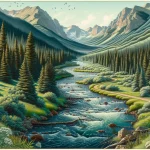South River Peak, standing at an impressive 13,154 feet (4,009 meters), is a prominent summit in the San Juan Mountains of southern Colorado. This majestic peak is located in Mineral County and is part of the Weminuche Wilderness within the Rio Grande National Forest.
In This Article
TL;DR
- South River Peak is a significant summit in Colorado's San Juan Mountains, offering stunning views and diverse outdoor activities.
- The peak features unique geological formations and is composed of ancient quartzite rock.
- The best times to visit South River Peak are during the summer months, from July to September, when weather conditions are most favorable.
Located in the San Juan Mountains, of the southwestern Rocky Mountain National Park area in Colorado, South River Peak stands as the apex of the South San Juan Wilderness area within the Rio Grande National Forest. With an impressive elevation soaring to around 13,148 feet, this peak claims its position as one of the most difficult of the Colorado 13ers.
Exploring the Trails Around South River Peak
The area surrounding South River Peak offers a variety of hiking trails for outdoor enthusiasts. One popular route is the Colorado Trail, which passes near the base of the mountain. This trail provides access to beautiful wildflower meadows and stunning vistas of the surrounding peaks.
When navigating the terrain, be prepared for steep and rocky sections. Sturdy hiking boots, plenty of water, and a map or GPS device are essential. Keep an eye out for wildlife, such as marmots, pikas, and bighorn sheep, which inhabit the high-altitude environment.
High-Altitude Adventures: Mountaineering on South River Peak
For those seeking a more challenging experience, South River Peak offers excellent mountaineering opportunities as one of the most difficult of the Colorado 13ers. Before embarking on a climb, ensure you have the necessary skills, experience, and equipment. Helmets, ropes, and proper footwear are crucial for safety.
The standard route to the summit involves a Class 2 climb, with some exposure and loose rock. It’s essential to check weather conditions and be prepared for rapid changes, as afternoon thunderstorms are common in the summer months.
The Climber’s Haven: Rock Climbing Opportunities
South River Peak and its surrounding areas provide a variety of rock climbing options for enthusiasts. The peak itself is composed of ancient quartzite rock, offering solid and challenging climbs. The nearby Weminuche Wilderness is home to numerous granite cliffs and boulder fields, catering to different climbing styles and skill levels.
For those new to climbing or looking to improve their skills, local guide services and climbing clinics are available in nearby towns like Silverton and Durango.
Navigating the Weather: Seasonal Considerations
The San Juan Mountains are known for their unpredictable weather, especially at high elevations. Summer months (July to September) offer the most stable conditions for outdoor activities, with warm days and cool nights. However, afternoon thunderstorms are common, so it’s crucial to start early and be prepared for sudden changes.
In the shoulder seasons (June and October), snow and ice can still linger on the trails and climbing routes, requiring additional gear and expertise.
Essential Gear and Preparation for Outdoor Activities
When planning your visit to South River Peak, it’s essential to come prepared with the right gear. For hiking and mountaineering, sturdy boots, warm layers, a waterproof jacket, and a reliable backpack are must-haves. Don’t forget to bring plenty of water, snacks, and sun protection.
For rock climbing, a helmet, harness, rope, and appropriate shoes are essential. If you’re new to the area or lack certain gear, local outfitters in nearby towns can provide rentals and advice.
Capturing the Beauty: Photography and Sightseeing
South River Peak and the surrounding wilderness offer countless opportunities for photography enthusiasts. The peak’s summit provides panoramic views of the San Juan Mountains, while the wildflower-filled meadows and alpine lakes create stunning foregrounds.
For the best lighting conditions, plan to shoot during the golden hours – early morning or late afternoon. Remember to practice ethical wildlife photography by maintaining a safe distance and not disturbing the animals’ natural behavior.
Conservation Efforts and Respectful Tourism
As a visitor to South River Peak and the Weminuche Wilderness, it’s crucial for you to practice Leave No Trace principles. This includes packing out all trash, camping in designated areas, and minimizing your impact on the delicate alpine environment.
Consider volunteering with local conservation organizations or participating in trail maintenance projects to help preserve this beautiful area for future generations.
FAQ
What is the best time of year to visit South River Peak for outdoor activities?
The best time to visit South River Peak is during the summer months, from July to September, when weather conditions are most favorable for hiking, climbing, and other outdoor activities.
Are there any guided tours available for South River Peak’s trails and climbs?
Yes, local guide services based in nearby towns like Silverton and Durango offer guided hikes, climbs, and mountaineering expeditions in the South River Peak area.
What should climbers specifically prepare for when tackling South River Peak?
Climbers should be prepared for Class 2 terrain, exposure, and loose rock on the standard route to the summit. Proper gear, including helmets, ropes, and sturdy footwear, is essential for safety.
How can visitors contribute to the conservation of South River Peak?
Visitors can contribute to the conservation of South River Peak by practicing Leave No Trace principles, such as packing out trash, camping in designated areas, and minimizing their impact on the environment. Volunteering with local conservation organizations is another great way to support the area.
Are there any restrictions or permits required for outdoor activities at South River Peak?
As South River Peak is located within the Weminuche Wilderness, certain wilderness regulations apply, such as group size limits and camping restrictions. However, no specific permits are required for day hikes or climbs. It’s always a good idea to check with the Rio Grande National Forest for the most up-to-date information on regulations and restrictions.
What are Colorado 13ers, and how many are there?
Colorado’s reputation for towering peaks is exemplified by its numerous “thirteeners” – mountains exceeding 13,000 feet. With 637 such peaks, the state beckons outdoor enthusiasts with a diverse array of hiking and climbing opportunities, from accessible trails to demanding ascents requiring technical skill. Other notable 13ers and 14ers (over 14,000 feet) include Sunshine Peak, Quandary Peak, Mount Wilson, Mount Evans, Bald Mountain, Mount Ouray, Mount Sneffels, Mound Herard, Mount Elbert, and West Spanish Peak.






